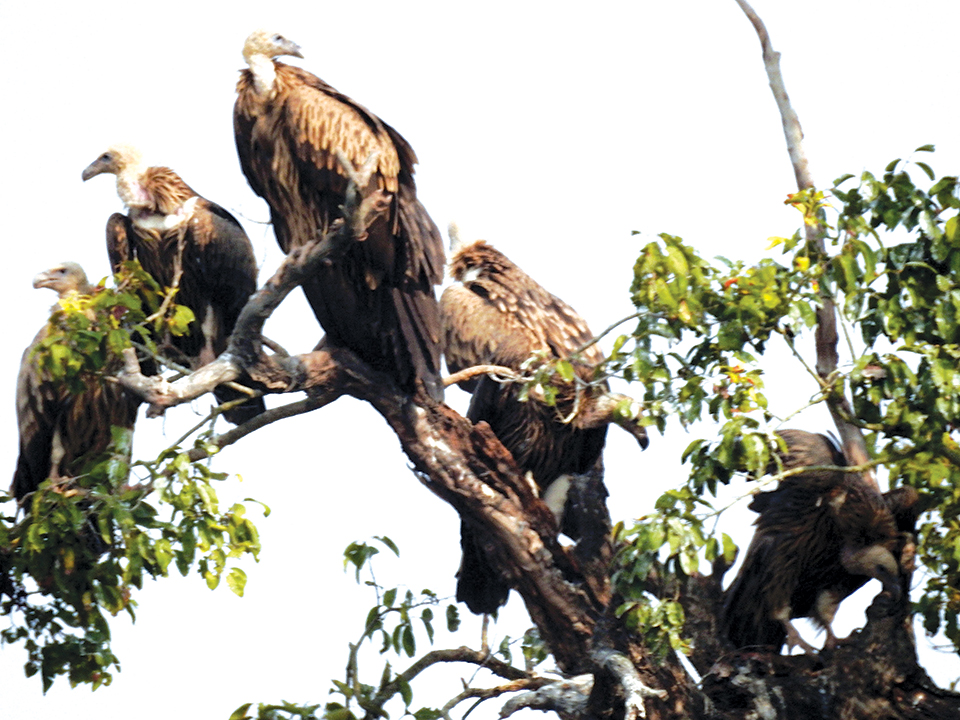
OR
Vultures return to Shuklaphanta National Park
Published On: September 16, 2019 09:48 AM NPT By: RAJENDRA BHATTA

MAHENDRANAGAR, Sept 16: As a small kid, Mohan Negi of Majhagaun village used to see huge wake of vultures fighting around the carcasses of dead animals. He reminisces that these vultures used to very big. He used to get very excited observing these vultures. “I would consider them mightiest among birds; they were so energetic and passionate,” he reminisced.
His house was near Shuklaphanta National Park and that would allow close and fascinating view of the surrounding wildlife. As such since his childhood, he developed an emotional bonding with animals, birds and nature.
He feels very sad when he compares the present condition with the past. Over these years, bird and wildlife population in the neighboring national park has declined considerably, he says.
“Over the years, most of the birds have almost disappeared from our skies. Nowadays vultures have stopped coming here. Many other birds have also gradually declined,” he said, sounding sad.
However, just few months ago, he suddenly saw some vultures in the vicinity and his fading memory came back to life.
Negi, who is in his 50’s now, is aware of the stories behind the decline and now the growth of the vulture population. Among other reasons, one of the reasons behind the decline of vulture population is supposed to have been decline in food. They had to struggle for food as people started burying dead animals instead of making them available for the vultures.
“When people started burying dead animals it became a huge challenge for the survival of scavengers,” he notes. “And then there was environmental degradation overall, which obviously threatened the existence of the entire wildlife including birds,” he added.
Another major thing that took a toll on vultures’ population was the use of Diclofenac. Used widely in veterinary medicine to treat various types of inflammation, but it is most commonly prescribed for inflammatory conditions of the eye, this turned out to be fatal for the vultures that ate animal carcasses treated with the medicine.
“Diclofenac harmed the vulture populations for many years. By the time it was banned, it had already harmed many species of the vulture,” said Negi.
Nepal government had banned the use of diclofenac in 2006. By that time, conservationists say, the chemical had done enough damage to vultures.
“For many years, vultures remained non-existent in this area. I used to wonder about the cause. But when I realized the impact of their absence on the environment, I really became worried,” remarks Negi.
But several years after the ban on the drug along with other measures taken by conservationists for preserving the species, vultures have started to return in the locality.
“The vultures that I saw recently were the collective effort of conservationists, local residents and the national and international community,” said Negi. “We should ramp up conservation efforts.”
According to Krishna Prasad Bhushal, program officer of Bird Conservation Nepal, seven types of vultures are found in Kanchanpur, among 23 species of vultures found across the world. “In total, nine species of vultures are found in Nepal; in Kanchanpur seven of them are found. All over the world, a total of 23 species of vultures have been recorded,” he informed.
Bhushal further stated that the species of vultures found in Nepal are among the rare types. It is very essential to conserve them, he stressed.
Dhudtha Rana, president of Nature Guide Association stated that vultures, which are also called natural cleaners, can thrive further in Nepal if more efforts are made by the government and the locals.
“Growth seen in flora and fauna is a good indication for the conservation of birds. Growing number of community forest are contributing to their conservation,” he said.
Private parties in Bannikheda, Tarapur and Hirapur, Beldangi, among other areas are working for vulture conservation. “We see many vultures in those areas nowadays,” he stated.
Meanwhile, Hirulal Dangaura, a member of BCN estimated the vultures’ number to be around 200 in Kanchanpur. “It is very sad that there are very few vultures left now. We have to do our best to grow their numbers,” he said.
In the 1980s, Nepal was home to over a million vultures. BCN records claim that over the decades their population declined by 90 percent.
From 2000, several community forests in Nepal were made aware of the need to save vultures and given support by various organizations for the purpose. Vulture restaurant was opened in Nawalparasi.
You May Like This

Amazon confirms two employees in Italy have contracted coronavirus
WASHINGTON, March 2: Amazon.com Inc said late on Sunday that two employees in Milan, Italy, have contracted the coronavirus and... Read More...

Mysterious disease killing dogs in Norway
HELSINKI, Sept 8: Norwegian authorities haven’t been able to detect the cause behind an unexplained disease that is estimated to... Read More...

Smugglers’ go-downs near customs office
SIRAHA, March 16: On March 10, a team from the District Police Office (DPO), Siraha, arrested a truck with an... Read More...







Just In
- NRB to provide collateral-free loans to foreign employment seekers
- NEB to publish Grade 12 results next week
- Body handover begins; Relatives remain dissatisfied with insurance, compensation amount
- NC defers its plan to join Koshi govt
- NRB to review microfinance loan interest rate
- 134 dead in floods and landslides since onset of monsoon this year
- Mahakali Irrigation Project sees only 22 percent physical progress in 18 years
- Singapore now holds world's most powerful passport; Nepal stays at 98th











Leave A Comment